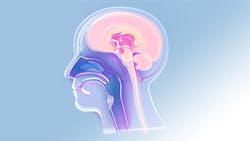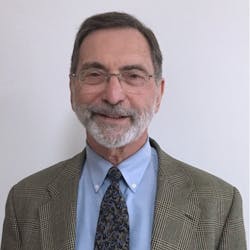The need for COVID-19 nasal protection is as plain as the nose on your face
Sponsored article
The pandemic is entering a new phase. Many of us are now fully vaccinated. But there is evidence to show that a fully vaccinated individual can still be an active, asymptomatic carrier for SARS-CoV-2.1 Breakthrough infections after vaccination do occur and are likely undercounted, according to the Centers for Disease Control and Prevention.2 Approximately 1% of breakthrough cases have resulted in death.2
Let’s also not forget that a small minority of patients who have recovered from COVID-19 infections have become reinfected.3 Of further concern and of unknown impact are the mutant variants of the SARS-CoV-2 virus.4 Will we need booster shots? Only time will tell.
To protect our patients and ourselves, we must continue to practice meticulous infection control. Fortunately, PPE and supply shortages have eased and a molecular iodine prerinse has recently become available that in university testing reduces the SARS-CoV-2 viral load to below the limits of detectability (ioRinse, IoTech International).5
Traditional infection control measures are critically important, but there is still a glaring chink in our infection control armor. While we have taken robust steps to mitigate potential viral loads in oral aerosols, we have completely ignored the viral load originating from a primary source of SARS-CoV-2 infection, the nose.
A recent study from the University of North Carolina Medical School and the National Institutes of Health has shown that the nose is the primary site of COVID-19 respiratory infection and that the virus is exhaled from infected individuals in normal breathing.6
Other studies have shown that higher viral loads are found in the nasal passages than are found in the mouth.7-9 Ear, nose, and throat (ENT) physicians are fully aware of the need to minimize the viral load from the nasal passages of infected patients both pre- and intra-operatively.
Viruses are not the only reason for nasal hygiene. A journal article reporting on the prevalence of Staphylococcus aureus infections of the nasal cavity concludes that 20% of adults are persistently infected, while 60% of adults are intermittently infected.10
What practical measures will offer protection from nasally-generated viral aerosols? Many ENT physicians have patients spray and irrigate their nasal passages with a molecular iodine solution each day for several days prior to the patient’s appointment. The patient is asked to spray, again, on the day of the exam or procedure. Pre- and intra-operatively, the patient’s nasal passages are coated with a molecular iodine nasal barrier cream (personal communication, ENT and Allergy Associates, April 2020).
There is a very simple and cost-effective approach that we can take prior to any dental procedure that should offer substantive nasal protection. By simply swabbing the internal surfaces of the patient’s nostrils with an effective antimicrobial cream, two additional layers of protection are provided. First, microbes will be inactivated by the biocide in the cream. Secondly, the cream itself, in coating the mucosal surfaces, will act as a physical barrier to the shedding of virus and the generation of microbial aerosols. Either the patient or professional staff can coat both nostrils in seconds.
Both povidone iodine and molecular iodine have been recommended for this additional barrier protection. A study conducted at the University of Southern California Medical School has shown that nasal treatment with molecular iodine is more effective as an antimicrobial agent than is povidone iodine.10 That would make sense, since povidone iodine owes all of its biocidal activity to the trace amounts of molecular iodine present.11 In contrast, the molecular iodine nasal product tested in the study had more than 100 times the available molecular iodine than did povidone iodine.
A 2019 JADA article reviewed rigorous studies that had actually measured the reduction of aerosolized microbes generated during dental procedures.12 The outcome of each of those studies was consistently clear: antimicrobial prerinses are effective in reducing microbial aerosols. There was a wide range of effectiveness amongst the tested rinses.
So, it is up to each dental clinician to choose the prerinse with the greatest efficacy, consistent with a high degree of safety and reasonable cost.
Our profession recognizes the importance of using an effective preprocedural rinse to reduce the viral load of dental aerosols. We need to extend that protection to what is arguably an even more virulent breeding ground for COVID-19, the nose. Protection is easily accomplished with either a preprocedural molecular iodine nasal spray or with a preprocedural application of a molecular iodine nasal barrier cream. In providing this additional important protection, you will also be protecting your patients, your staff, your family, and yourself from other upper respiratory infections as well.13
Editor's note: This article appeared in the August 2021 print edition of RDH magazine.
References
- Bleier BS, Ramanathan M Jr, Lane AP. COVID-19 vaccines may not prevent nasal SARS-CoV-2 infection and asymptomatic transmission. Otolaryngol Head Neck Surg. 2021;164(2):305-307. doi:10.1177/0194599820982633
- COVID-19 Vaccine breakthrough case investigation and reporting. Centers for Disease Control and Prevention. https://www.cdc.gov/vaccines/covid-19/health-departments/breakthrough-cases.html
- Reinfection with COVID-19. Centers for Disease Control and Prevention. https://www.cdc.gov/coronavirus/2019-ncov/your-health/reinfection.html
- Science brief: Emerging SARS-CoV-2 variants. Centers for Disease Control and Prevention. January 28, 2021
- Moskowitz H, Mendenhall M. Comparative analysis of antiviral efficacy of four different mouthwashes against severe acute respiratory syndrome coronavirus 2: an in-vitro study. Int J Experiment Dent Sci. 2020;9(1):1-3. doi:10.5005/jp-journals-10029-1209
- Hou YJ, Okuda K, Edwards CE, et al. SARS-CoV-2 reverse genetics reveals a variable infection gradient in the respiratory tract. Cell. 2020;182(2):429-446.e14. doi:10.1016/j.cell.2020.05.042
- Frank S, Capriotti J, Brown SM, Tessema B. Povidone-iodine use in sinonasal and oral cavities: a review of safety in the COVID-19 era. Ear Nose Throat J. 2020;99(9):586-593. doi:10.1177/0145561320932318
- Zou L, Ruan F, Huang M, et al. SARS-CoV-2 viral load in upper respiratory specimens of infected patients. N Engl J Med. 2020;382(12):1177-1179. doi: 10.1056/NEJMc2001737
- Guenezan J, Garcia M, Strasters D, et al. Povidone iodine mouthwash, gargle, and nasal spray to reduce nasopharyngeal viral load in patients with COVID-19: a randomized clinical trial. JAMA Otolaryngol Head Neck Surg. 2021;147(4):400-401. doi:10.1001/jamaoto.2020.5490
- Uchiyama S, Dahesh S, Nizet V, Kessler J. Enhanced topical delivery of non-complexed molecular iodine for methicillin-resistant Staphylococcus aureus decolonization. Int J Pharm. 2019;554:81-86. doi:10.1016/j.ijpharm.2018.11.004
- Moskowitz H. CHX: We don’t like It! Why are we still using it? RDH magazine.July 1, 2019. https://www.rdhmag.com/career-profession/article/14036891/chx-we-dont-like-it-why-are-we-still-using-it
- Marui VC, Souto MLS, Rovai ES, Romito GA, Chambrone L, Pannuti CM. Efficacy of preprocedural mouthrinses in the reduction of microorganisms in aerosol: s systematic review. J Am Dent Assoc. 2019;150(12):1015-1026.e1. doi:10.1016/j.adaj.2019.06.024
- Voisine R. Povidone-idoine as a preprocedural nasal and mouthrinse prophylaxis for COVID-19. Anesthesiology News. August 20, 2020. https://www.anesthesiologynews.com/Commentary/Article/08-20/Povidone-Iodine-as-a-Preprocedural-Nasal-and-Mouthrinse-Prophylaxis-for-COVID-19/59345

